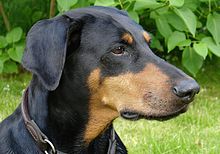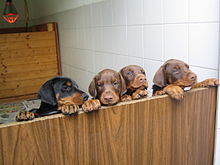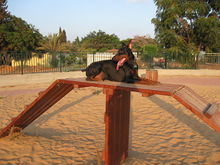Dobermann
Lifespan: 10 – 13 y
Temperament: Alert, Obedient, Loyal, Energetic, Fearless, Intelligent
Colors: Red, Fawn, Blue, Black, White
Height: 64.8 cm (Female, Adult), 69.8 cm (Male, Adult)
Mass: 34 – 41 kg (Male, Adult), 27 – 36 kg (Female, Adult)
The Doberman Pinscher (alternatively spelled Dobermann in many countries) or simply Doberman, is a breed of domestic dog originally developed around 1890 by Karl Friedrich Louis Dobermann, a tax collector from Germany. Doberman Pinschers are among the most common of pet breeds, and the breed is well known as an intelligent, alert, and loyal companion dog. Although once commonly used as guard dogs or police dogs, this is less common today.[citation needed]
In many countries, Doberman Pinschers are often one of the most recognizable breeds, in part because of their actual roles in society, and in part because of media attention. Recent careful breeding has greatly improved the disposition of this breed, and the modern Doberman Pinscher is an energetic and lively breed suitable for companionship and family life. Although many Dobermans have been outdoor dogs, they are best suited to live indoors.
Size and proportions[edit]
The Doberman is a dog of medium size. Although the breed standards vary among kennel and breed clubs, the dog typically stands between 26 to 28 inches, 27.5 being ideal (66 to 72 cm), the female is typically somewhere between 24 to 26 inches, 25.5 being ideal (61 to 68 cm).[1][3] The Doberman has a square frame: its length should equal its height to the withers, and the length of its head, neck and legs should be in proportion to its body.[1] European lines, particularly those from the former Yugoslavia and former Soviet Union, tend to be larger than those in North America.
There are no standards for the weight of the Doberman Pinscher. The ideal dog must have sufficient size for an optimal combination of strength, endurance and agility.[3] The male generally weighs between 75-90.4 lbs. (34 and 45 kg) and the female between 59.5-79.4 pounds (27 and 41 kg).
Color[edit]
Two different color genes exist in the Doberman, one for black (B) and one for color dilution (D). There are nine possible combinations of these alleles (BBDD, BBDd BbDD BbDd, BBdd, Bbdd, bbDD, bbDd, bbdd), which result in four different color phenotypes: black, red, blue, and fawn (Isabella).[4] The traditional and most common color occurs when both the color and dilution genes have at least one dominant allele (i.e., BBDD, BBDd, BbDD or BbDd), and is commonly referred to as black or black and rust (also called black and tan). The red, red rust or brown coloration occurs when the black gene has two recessive alleles but the dilution gene has at least one dominant allele (i.e., bbDD, bbDd). "Blue" and "fawn" are controlled by the color dilution gene. The blue Doberman has the color gene with at least one dominant allele and the dilution gene with both recessive alleles (i.e., BBdd or Bbdd). The fawn (Isabella) coloration is the least common, occurring only when both the color and dilution genes have two recessive alleles (i.e., bbdd). Thus, the blue color is a diluted black, and the fawn color is a diluted red.
Expression of the color dilution gene is a disorder called Color Dilution Alopecia. Although not life threatening, these dogs can develop skin problems.[5]
In 1976, a "white" Doberman Pinscher was whelped,[6] and was subsequently bred to her son, who was also bred to his litter sisters. This tight inbreeding continued for some time to allow the breeders to "fix" the mutation. White dobermans are a cream color with pure white markings and icy blue eyes. Although this is consistent with albinism, the proper characterization of the mutation is currently unknown. The animals are commonly known as tyrosinase-positive albinoids, lacking melanin in oculocutaneous structures,[7] but no known mutation has been identified.
Tails[edit]
The Doberman Pinscher's natural tail is fairly long, but individual dogs often have a short tail as a result ofdocking, a procedure in which the majority of the tail is surgically removed shortly after birth.
The practice of docking has been around for centuries, and is older than the Doberman as a breed.[8] The putative reason for docking is to ensure that the tail does not get in the way of the dog's work.[8] Docking has always been controversial.[9] The American Kennel Club standard for Doberman Pinschers includes a tail docked near the 2nd vertebra.[1] Docking is a common practice in the United States, Russia and Japan (as well as a number of other countries with Doberman populations), where it is legal. In many European countries, docking has been made illegal, and in others it is limited.
Ears
Doberman Pinschers often have their ears cropped, as do many other breeds, a procedure that is functionally related to breed type for both the traditional guard duty and effective sound localization. According to the Doberman Pinscher Club of America, ears are "normally cropped and carried erect".[10]Like tail docking, ear cropping is illegal in some countries, and in these pictures Doberman Pinschers have natural ears. Doberman Pinscher ear cropping is usually done between 7 and 9 weeks of age and is done under anesthesia. Cropping done after 12 weeks has a low rate of success in getting the ears to stand.
In some countries' conformation shows,[specify] Doberman Pinschers are allowed to compete with either cropped or natural ears. In Germany a cropped or docked dog cannot be shown regardless of country of origin. Special written exception to this policy does occur when Germany is the location for international events.
Whether cropping the ears actually reduces the risk of ear infections as opposed to leaving the ears pendulous has been contested.[citation needed]


Temperament[edit]
Although they are considered to be working dogs, Doberman Pinschers are often stereotyped as being ferocious and aggressive. As a personal protection dog, the Doberman was originally bred for these traits: it had to be large and intimidating, fearless, and willing to defend its owner, but sufficiently obedient and restrained to only do so on command. These traits served the dog well in its role as a personal defense dog, police dog, or war dog, but were not ideally adapted to a companionship role. The Doberman Pinscher's aggression has been toned down by modern breeders over the years, and today's Dobermans are known for a much more even and good natured temperament, extreme loyalty, high intelligence, and great trainability. In fact, the Doberman Pinscher's size, short coat, and intelligence have made it a desirable house dog.
They can easily learn to 'Respect and Protect' their owners, and are therefore considered to be excellent guard dogs that protect their loved ones. They are generally sociable toward humans and can be with other dogs. However, Dobermans rank among the more-likely breeds to show aggressive behaviour toward strangers and other dogs, but not among the most likely to do so. They are very unlikely to show aggressive behaviour toward their owners.
There is evidence that Doberman Pinschers in North America have a calmer and more even temperament than their European counterparts because of the breeding strategies employed by American breeders.[11] Because of these differences in breeding strategies, different lines of Doberman Pinschers have developed different traits. Although many contemporary Doberman Pinschers in North America are gentle and friendly to strangers, some lines are bred more true to the original personality standard.[12]
Although the aggressiveness stereotype is less true today, the personality of the Doberman Pinscher is unique. There is a great deal of scientific evidence that Doberman Pinschers have a number of stable psychological traits, such as certain personality factors and intelligence. As early as 1965, studies have shown that there are several broad behavioral traits that significantly predict behavior and are genetically determined.[13] Subsequently, there have been numerous scientific attempts to quantify canine personality or temperament by using statistical techniques for assessing personality traits in humans. These studies often vary in terms of the personality factors they focus on, and in terms of ranking breeds differently along these dimensions. One such study found that Doberman Pinschers, compared to other breeds, rank high in playfulness, average in curiosity/fearlessness, low on aggressiveness, and low on sociability.[14] Another such study ranked Doberman Pinschers low on reactivity/surgence, and high on aggression/disagreeableness and openness/trainability.[15]
Intelligence[edit]
Canine intelligence is an umbrella term that encompasses the faculties involved in a wide range of mental tasks, such as learning, problem-solving, and communication. The Doberman Pinscher has ranked amongst the most intelligent of dog breeds in experimental studies and expert evaluations. For instance, Psychologist Stanley Coren ranks the Doberman as the 5th most intelligent dog in the category of obedience command training, based on the selective surveys he performed of some trainers (as documented in his book The Intelligence of Dogs). Additionally, in two studies, Hart and Hart (1985) ranked the Doberman Pinscher first in this category.[16] and Tortora (1980) gave the Doberman the highest rank in trainability.[17] Although the methods of evaluation differ, these studies consistently show that the Doberman Pinscher, along with the Border Collie, German Shepherd, Golden Retriever and Standard Poodle, is one of the most trainable breeds of dog.
Aggression[edit]
In addition to the studies of canine personality, there has been some research to determine whether there are breed differences in aggression. In a recent study, aggression was divided into four categories: aggression directed at strangers, owner, strange dogs and rivalry with other household dogs.[18] This study found that the Doberman Pinscher ranked relatively high on stranger-directed aggression, but extremely low on owner-directed aggression. The Doberman Pinscher ranked as average on dog-directed aggression and dog rivalry. Looking only at bites and attempted bites, Doberman Pinschers rank as far less aggressive towards humans, and show less aggression than many breeds without a reputation (e.g., CockerSpaniel, Dalmatian and Great Dane). This study concluded that aggression has a genetic basis, that the Doberman shows a distinctive pattern of aggression depending on the situation, and that contemporary Doberman Pinschers are not an aggressive breed overall.[18]
Although recent studies do not rank Doberman Pinschers as the most aggressive breed, their size, strength and aggression towards strangers makes them potentially dangerous.[19]
According to the Centers for Disease Control and Prevention, between 1979 and 1998, the Doberman Pinscher was involved in attacks on humans resulting in fatalities less frequently than several other dog breeds such as pit bull-type dogs, German Shepherd Dogs, Rottweilers, Husky-type, Wolf-dog hybrids and Alaskan Malamutes.[19][20] According to this Center for Disease Control and Prevention study, one of the most important factors contributing to dog bites are related to the level of responsibility exercised by dog owners.[21]
Health[edit]
The Doberman's lifespan is about 10–11 years, on average.[22] They may suffer from a number of health concerns. Common serious health problems include dilated cardiomyopathy,[23][24][25]cervical vertebral instability (CVI),[26] von Willebrand's disease (a bleeding disorder for which genetic testing has been available since 2000; the test enables both parents of a prospective litter to be tested for the carrier gene, thus preventing inheritance of the disease ),[23] and prostatic disease.[27] Less serious common health concerns include hypothyroidism and hip dysplasia.[28]Canine compulsive disorder is also common.[29] Studies have shown that the Doberman Pinscher suffers from prostatic diseases, (such as bacterial prostatiti, prostatic cysts, prostatic adenocarcinoma, and benign hyperplasia) more than any other breed. Neutering can significantly reduce these risks (see Dog for information).
Dilated cardiomyopathy is a major cause of death in Doberman Pinschers. This disease affects Dobermans more than any other breed.[30] Nearly 40% of DCM diagnoses are for Doberman Pinschers, followed by German Shepherds at 13%.[30] Research has shown that the breed is affected by an attenuated wavy fiber type of DCM that affects many other breeds,[31] as well as an additional, fatty infiltration-degenerative type that appears to be specific to Doberman Pinscher and Boxer breeds.[31] This serious disease is likely to be fatal in most Doberman Pinschers affected.[32]
Across multiple studies, more than half of the Doberman Pinschers studied develop the condition. Roughly a quarter of Doberman Pinschers who developed cardiomyopathy died suddenly from unknown causes,[31][33][34] and an additional fifty percent died of congestive heart failure[34] In addition to being more prevalent, this disease is also more serious in Doberman Pinschers. Following diagnosis, the average non-Doberman has an expected survival time of 8 months; for Doberman Pinschers, the expected survival time is less than 2 months.[30] Although the causes for the disease are largely unknown, there is evidence that it is a familial disease inherited as an autosomal dominant trait.[35] Investigation into the genetic causes of canine DCM may lead to therapeutic and breeding practices to limit its impact[36][37]







No comments:
Post a Comment